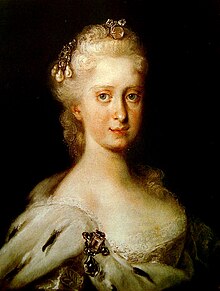Maria Josepha of Austria
| Maria Josepha of Austria | |
|---|---|
| Queen consort of Poland Grand Duchess consort of Lithuania Electress consort of Saxony | |
 | |
| Tenure | 1734 – 5 October 1763 |
| Coronation | 17 January 1734 Wawel Cathedral, Kraków |
| Born | 8 December 1699 Vienna, Austria |
| Died | 17 November 1757 (aged 58) Dresden, Saxony |
| Burial | |
| Spouse | Augustus III of Poland |
| Issue More | Frederick Christian, Elector of Saxony Maria Amalia, Queen of Spain Maria Anna Sophia, Electress of Bavaria Prince Franz Xavier Maria Josepha, Dauphine of France Carl, Duke of Courland Maria Christina, Abbess of Remiremont Albert, Duke of Teschen Clemens Wenceslaus, Archbishop of Trier Maria Kunigunde, Abbess of Essen |
| House | House of Wettin House of Habsburg |
| Father | Joseph I, Holy Roman Emperor |
| Mother | Wilhelmina Amalia of Brunswick |
| Religion | Roman Catholicism |
Maria Josepha of Austria (Maria Josepha Benedikta Antonia Theresia Xaveria Philippine, Template:Lang-pl; 8 December 1699 – 17 November 1757) was born an Archduchess of Austria, and from 1711 to 1713 was heiress presumptive to the Habsburg Empire. By her marriage to Augustus of Saxony she was the Electress of Saxony and Queen consort of the Polish-Lithuanian Commonwealth.
Family
Maria Josepha was born in Vienna, an Archduchess of Austria as the eldest child of Joseph I, Holy Roman Emperor, and Princess Wilhelmina Amalia of Brunswick-Lüneburg. During the reign of her grandfather, Maria Josepha's father and uncle signed the decree which made the eldest daughter of Joseph I heiress of the Habsburg dominions provided that both he and his younger brother fail to have sons. However, during the reign of their uncle Charles VI, Maria Josepha and her sister were excluded from the Habsburg succession in favour of their cousin Maria Theresa by the Pragmatic Sanction of 1713.
The Mutual Pact of Succession of 1703, issued by her grandfather, Emperor Leopold I, effectively made Maria Josepha the heiress presumptive to her uncle, Emperor Charles VI;[1] however, Charles VI's Pragmatic Sanction of 1713 annulled the earlier agreement and made his daughter Maria Theresa his successor instead of Maria Josepha.
Marriage

A marriage between Maria Josepha and Frederick Augustus II, Elector of Saxony (1733–1763) had been suggested by Frederick's father, August II the Strong, since 1704. The fact that Maria Josepha was not allowed to marry a non-Catholic, however, prevented the marriage. When Augustus converted to Catholicism in 1712, the negotiations became serious. On 20 August 1719, Maria Josepha and Frederick Augustus married. Through this marriage between the Houses of Wettin and Habsburg, Frederick Augustus II's father, hoped to place Saxony in a better position should there arise a war of succession to the Austrian territories.[2] The couple's eldest surviving son, Frederick Christian, eventually succeeded his father as Elector of Saxony.
The couple lived at Dresden Castle.
In 1733, Frederick Augustus was elected King of the Polish-Lithuanian Commonwealth as August III the Saxon.[2] Maria Josepha was crowned 20 January 1734. Queen Maria Josepha was described as ambitious, intelligent and religious. She founded many churches and convents and gave her strong support to the Polish Jesuits. In 1740, she claimed the rights to the throne of Austria, but not for herself but for her spouse. She relinquished her claim in 1742, and soon made an alliance with Austria. During the seven years war in 1756, Maria Josepha stayed behind in Dresden, after her husband left, when the city was taken by the Prussian army.[3] She died of a stroke during the Prussian occupation.
On 17 November 1757, Maria Josepha died in Dresden of a stroke and was buried in the Wettin vault of the Katholische Hofkirche ("Catholic Court Church") in Dresden.[4]
Issue
Maria Josepha and Frederick Augustus had fourteen children:[5]
- Frederick August of Saxony (1720–1721) died in infancy.
- Prince Joseph August of Saxony (1721–1728) died in infancy.
- Frederick Christian, Elector of Saxony (1722–1763) married Maria Antonia of Bavaria and had issue.
- Maria Amalia of Saxony (1724–1760) married Charles III of Spain and had issue.
- Maria Margaretha of Saxony (1727–1734) died in infancy.
- Maria Anna Sophia of Saxony (1728–1797) married Maximilian III Joseph, Elector of Bavaria and had no issue.
- Francis Xavier of Saxony (1730–1806) married morganatically Maria Chiara Spinucci and had issue.
- Maria Josepha of Saxony (1731–1767) married Louis, Dauphin of France and had issue.
- Charles of Saxony (1733–1796) married Franciscka of Corvin-Krasinska and had issue.
- Maria Elisabeth of Saxony (1736–1818) died unmarried.
- Maria Christina of Saxony (1735–1782) died unmarried.
- Albert of Saxony (1738–1822) married Maria Christina of Austria and had issue.
- Clemens Wenceslaus of Saxony (1739–1812) died unmarried.
- Maria Kunigunde of Saxony (1740–1826) died unmarried.
Ancestry
References
- ^ "Under the Pactum Mutuae Successionis of 1703 (a purely family agreement) Charles [VI] had succeeded before his nieces, and his son, if he had one, would follow him, but if he died childless, or left only daughters, Joseph's daughters should have succeeded him." (Potter, p. 393).
- ^ a b Watanabe-O'Kelly, p. 265.
- ^ Watanabe-O'Kelly, p. 270.
- ^ Watanabe-O'Kelly, p. 271.
- ^ Watanabe-O'Kelly, p. 266.
Sources
- Template:Equivalent
- Potter, George R. The New Cambridge Modern History.
- Helen, Watanabe-O'Kelly (2004). "Religion and the Consort: Two Electresses of Saxony and Queens of Poland (1697-1757)". In Campbell Orr, Clarissa (ed.). Queenship in Europe 1660-1815: The Role of the Consort. Cambridge University Press. pp. 252–275. ISBN 0-521-81422-7.
External links
![]() Media related to Maria Josepha of Austria, Queen of Poland at Wikimedia Commons
Media related to Maria Josepha of Austria, Queen of Poland at Wikimedia Commons
